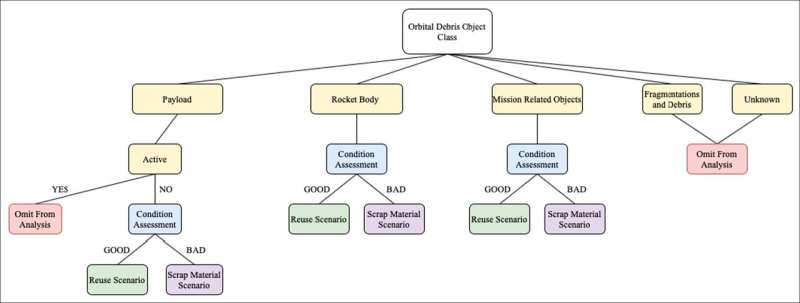This article has been reviewed according to Science X's editorial process and policies. Editors have highlighted the following attributes while ensuring the content's credibility:
fact-checked
trusted source
proofread
A circular economy to tackle space junk

Southampton researchers have developed the world's first robust method for estimating the value and mass of space junk.
A fully circular economy for space—removing space junk and reusing or recycling it—is a viable possibility to safeguard the future for satellites and space exploration, according to new research from the University of Southampton.
The research estimates there is billions, potentially trillions, of dollars' worth of recyclable materials, in the form of space junk (mission debris and defunct satellites), orbiting the Earth. Knowing what is 'out there' will enable viable solutions to the growing problem to be effectively and justifiably pursued.
Space junk is a form of pollution that poses a threat to future space exploration and satellites—which we rely heavily on here on Earth.
As of January 2021, the US Space Surveillance Network reported 21,901 artificial objects in orbit around Earth, including almost 4,500 functioning satellites. But these are just the objects large enough to be tracked. There is also estimated to be more than 128 million pieces of debris smaller than 1cm, more than 900,000 pieces measuring 1cm to 10cm, and 34,000 pieces larger than 10cm.
Ian Williams, Professor of Applied Environmental Science, and Applied GIS and Remote Sensing Master's graduate Ryan Leonard have developed a method to estimate the value and mass of orbital debris—providing a case for a circular economy.
"If the financial value of retrieving space debris is high enough, investment into the technology to do so is justified," said Professor Williams.
Through their research, Professor Williams and Mr. Ryan calculated the reuse of space junk could have a net value of between $570 billion and $1.2 trillion.This amounts to somewhere between 5,312 and 19,124 tons of scrap metal. Active debris removal (ADR)—such as the plasma thruster invented by the University of Southampton's Dr. Minkwan Kim, which is designed to safely deorbit end-of-life satellites—is one possible solution.
Professor Williams added, "The development of in-orbit services, such as extending the life of inactive satellites, or the advancement of ADR, will be crucial to solve the orbital debris problem. But, with this, a future circular economy for space may be financially viable, with potentially beneficial consequences for risk reduction; resource efficiency; additional high-value employment; and climate-change knowledge, science, monitoring and early warning data."
The research findings are published in the journal Waste Management.
More information: Ryan Leonard et al, Viability of a circular economy for space debris, Waste Management (2022). DOI: 10.1016/j.wasman.2022.10.024
Provided by University of Southampton





















